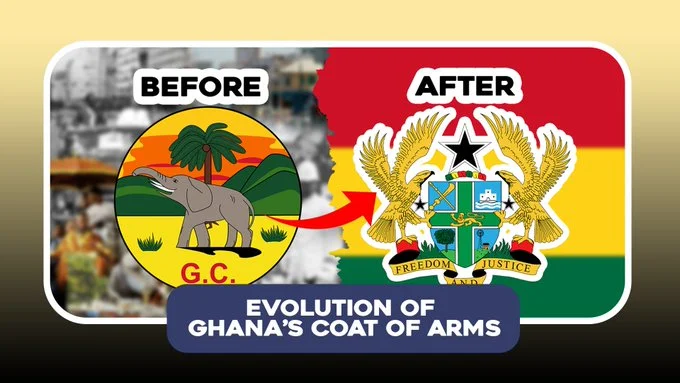The Coat of Arms functions as a country’s logo, symbolizing its identity and values.
Paired with the Ghanaian flag, it appears on official documents, letterheads, and as badges denoting membership or allegiance.
Heraldry, the system regulating armorial bearings, originated in England around 1100 when knights painted unique ‘arms’ on shields for recognition.
Ghana’s Coat of Arms has undergone changes for sometime now, the first which was introduced during the Gold era has an elephant featuring a tree, grasses with G.C boldly inscribed on it.
However in 1957, when the Gold Coast gained independence from Britain and adopted the name Ghana, the flag transitioned to a tricolor of red, gold, and green, adorned with a black five-pointed star.
Commissioned in 1956 by the British colonial government, the current Coat of Arms replaced symbols representing the West African British Colonies.
Ghana’s Coat of Arms bears a shield held by golden eagles, signifying watchful protection.
The shield’s blue background is divided into quarters, featuring symbols like a traditional sword, Christianborg Castle, a cocoa tree, and a mine shaft, representing traditional power, governance, agriculture, and mineral wealth.
A black star atop the shield symbolizes African freedom.’A black star atop the shield symbolizes African freedom.
The scroll beneath holds the motto “Freedom and Justice,” with grass on each side.
Mr. Nii Amon Kotei, a skilled surveyor and artist, designed it, incorporating elements symbolizing chieftaincy, government, mineral wealth, and fertile land.
Mr. Nii Amon Kotei’s Contribution:
Born on May 24, 1915, Mr. Kotei studied art in London after World War II service.
His design incorporated the elephant’s skin, symbolizing chieftaincy, the Castle for the Seat of Government, and motifs depicting the country’s mineral wealth and fertile land.
The draft underwent minor changes, approved by the Queen’s College of Heraldry in the UK.


